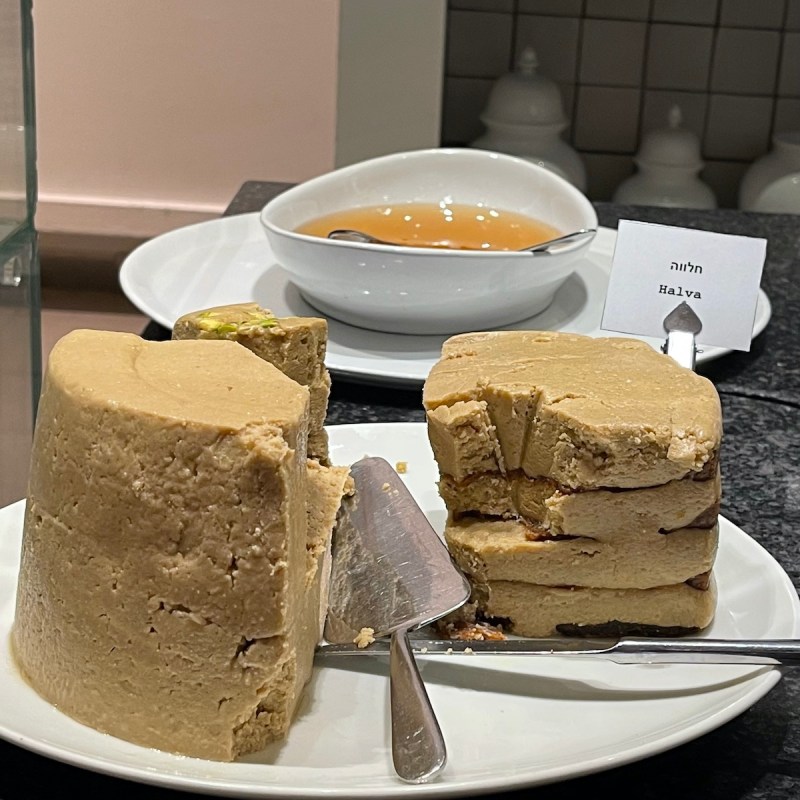
When visiting Israel, Ira and I look forward to starting our day with hearty, nutrient-dense breakfasts that are customarily included in the price of a guest room. These onsite restaurants are a morning mecca for foodies.
Videos by TravelAwaits
Larger hotels and resorts offer elaborate buffets showcasing an assortment of bakery goods, dairy products, fish, egg entrees like shakshuka, Israeli specialty items, a variety of salads made from local produce, and halva, a Middle Eastern specialty with a fudge-like consistency often made from sesame and sugar.
Labels in both English and Hebrew often identify the items and sometimes single out gluten-free, sugar-free, vegan, and vegetarian options. After traveling throughout the world, we rarely have experienced anything that comes close to the complexity of an Israeli buffet breakfast.
Lunch Is Secondary To An Engaging Itinerary
Since our private tours always maximize our time to experience a cross section of attractions in multiple regions throughout Israel, our daily itineraries usually have minimal time for a lunch or snack break.
Consuming a multi-course, healthy breakfast is the easiest way to meet the demands of these hectic travel days. Israeli guides sometimes stop for samples of local foods or small snacks. These reenergizing nosh breaks are welcome. However, our preference is to sample a cross section of breakfast foods rather than worrying about where we are going to stop for lunch.
Jewish Sabbath Restrictions
When traveling in Israel, visitors need to be aware that restaurants observing the Jewish laws pertaining to the Sabbath will have limited food service from sunset on Friday to sunset on Saturday. In these restaurants, it will be possible to order coffee or tea, but a cappuccino will have to wait.
Food ordered during this time will be prepared prior to the start of the Sabbath and kept warm until the items are served. While hotel restaurants will remain open with limited service, many restaurants close during the Sabbath.
To gain an appreciation for what you can sample, I will share what Ira and I experienced during our partially hosted Israel My Way tour, which included stays at the Mamilla Hotel in Jerusalem, Mitzpe Hayamim in the Galilee, The Norman in Tel Aviv, and the Beresheet in the Mitzpe Ramon. The three larger hotels offer a comprehensive buffet, while the boutique hotel had a tailored menu with traditional breakfast service. All opinions are my own.

1. Mamilla Hotel
In Jerusalem’s conveniently located Mamilla Hotel, the breakfast buffet is in the Ballroom on the lower level of the hotel. Oshri Zafrani, the head chef, relies on his decades of cooking experience in the Israel Defense Forces and in restaurants and bakeries throughout Israel to create the morning buffet experience.
When asked about the buffet, he stated “The main goal is to give variety to our hotel guests. This way, every diner will have no difficulties choosing food.” As we walked from station to station, we saw examples of how the restaurant accommodates common allergies and food trends. Vegans and vegetarians will likewise not be disappointed.
What To Eat At The Ballroom Restaurant Buffet
I requested a well-done version of the restaurant’s shakshuka. Their adaptation of this popular regional dish is served in individual pans that include poached eggs in a tomato sauce made with ripe tomatoes cooked with roasted peppers and generous amounts of fresh garlic. I paired this Middle Eastern favorite with an individual portion of vegetarian quiche.
Even though I rarely eat cheese, I couldn’t resist sampling some of the local cheeses which are specially made for the hotel at boutique dairies. However, most of my remaining selections came from the fresh vegetable sections. Noteworthy options included the roasted seasonal vegetables, beet salad with citrus slices, and a root salad tossed with an Asian vinaigrette.
When asked to single out the buffet’s most popular dishes, Chef Zafrani mentioned quiches, shakshuka, made-to-order omelets, Israeli salads, Belgian waffles, cheesecake, and breakfast pastries. Ira and I deviated slightly from our daily diet by tasting some of the whole grain breads that were baked at nearby bakeries, as well as a handful of breakfast pastries made in-house with several different flours.
We also took a few bites of the overly sweet jachnun, a Yemenite-Israeli dish traditionally eaten on Saturday morning. Unlike other dishes that are baked for a relatively short period, this food is baked throughout the night in a low-temperature oven. Chef Zafrani shared the ingredients — water, flour, butter, salt, sugar, and honey. After our first day, we often indulged in one of our favorite Israeli treats, halva.

2. Mitzpe Hayamim
When we traveled north to the Galilee, we stayed several nights at the Mitzpe Hayamim, a luxury resort with walking paths and gardens along with views of the Sea of Galilee and the adjacent countryside. With an onsite dairy and organic farm, Ira and I were assured to get the freshest farm-to-table ingredients.
The waitstaff told us that the dairy products — from milk to hard cheese — came from the resort’s farm and that the menu adapted to the seasonal vegetables grown and harvested onsite. With a shorter growing season and lifespan, the fruits are often made into jams or sauces. Whatever is not produced onsite is locally sourced.
Ronen Woldman’s domestic cooking experience, along with his experience at international restaurants run by Michelin star winners Alain Ducasse and Gordon Ramsay, prepared him to successfully take on the role of executive chef at this incredible hotel.
After returning home, Chef Woldman hopes that Mitzpe Hayamim guests “will remember the wonderful freshness of the resort’s cuisine. We pride ourselves in using fresh products — no cans, sauces, colorings, etc.”
What To Try At The Mitzpe Hayamim Restaurant Buffet
Ira and I were both attracted to a delicious herb omelet that was baked in an open oven, a local tradition. While corresponding with Chef Woldman, I learned that the secret to this tasty omelet was the generous amounts of cream whipped into the eggs. Had I known this fact, I may not have indulged. Trying to adhere to a particular diet while selecting items at a buffet is not always possible. In retrospect, I should have asked more questions before making selections.
We also tasted Mitzpe Hayamim’s version of shakshuka as well as items found on their rotating msabbaha station. These entrees were made of legumes, usually chickpeas, lentils, or lima beans. After the beans are thoroughly cooked, they are hand ground with a mortal and pestle. Generous amounts of lemon juice, garlic, and tahini are subsequently added.

3. The Norman
In Tel Aviv, our stay at The Norman offered a boutique hotel experience in the heart of the city. For breakfast, we dined at the shaded outdoor terrace where we selected items from a limited menu. Eight a-la-carte entrees — ranging from a bowl of granola with berries and yogurt to eggs Benedict — are available for breakfast.
What To Order From The Breakfast Menu At The Norman
The a-la-Norman is the best choice for guests who want a more filling start to the day. For a set price, guests are served a bread basket filled with a slice of sourdough bread, a Parker bun, a butter croissant, and an herb pastry along with a choice of scrambled eggs, poached eggs, a custom omelet, or three versions of shakshuka.
This selection comes with a cheese plate, an assortment of roasted peppers, some olives, a portion of quinoa tabbouleh, and a cherry tomato salad. A choice of hot and cold beverages is also included.
While a simple breakfast menu cannot compare to the multitude of foods presented in a buffet, there is a considerable value associated with being served quality foods on a lovely outdoor patio.

4. Beresheet Resort
To fully appreciate the magnitude of the Makhtesh Ramon in the Negev Desert, the world’s largest erosion crater, we stayed at the Beresheet Resort in Mitzpe Ramon. The onsite Rosemarine Restaurant offered the largest presentation during this trip, and like our experiences at the Mamilla Hotel and Mitzpe Hayamim, we had the option to sit inside or outside.
At the end caps of long countertops, bread baskets are filled with an assortment of items, prepared elsewhere and then later baked onsite. All the pastries and sweets are made in the hotel while the halva is provided by an outside purveyor. As we scoped out the buffet, it was challenging to narrow down our choices because there was an abundance of hot and cold dishes made with seasonal produce, dairy products, and fish.
What To Taste At The Rosemarine Restaurant Buffet
Fresh vegetables and an assortment of cheeses were combined in several enticing salads. Top choices included the Capreza salad and the roasted peppers with feta cheese salad. Our love for fish was fulfilled with the home pickled gravlox and smoked fish. We paired the fish with challah, a traditional braided egg bread baked for the Jewish Sabbath and holidays.
While we both ordered customized vegetarian omelets on Friday morning, the restrictions of the Jewish Sabbath prevented us from selecting any made-to-order entrees the next day. Our breakfast finale included tiny samples of the unique sweet potato quiche made with caramelized onions, a potpourri of items from the large vegan dessert counter, and a small slice of kanafeh, a traditional Middle Eastern dessert.
Pro Tip
Since it will be hard to resist returning for additional helpings, pace yourself so you aren’t late for your tour. If you have diet restrictions, don’t be shy. Whenever possible, ask questions about the ingredients. Restaurants that are certified kosher will either serve meat or dairy dishes and will not have pork or shellfish on the menu.

